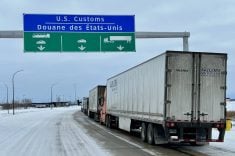Farmers have begun the hard work of cleaning up and restarting production following massive flooding that hit British Columbia.
“It’s almost a question of ‘where do you start?’” said B.C. Agriculture Minister Lana Popham. “Everything is covered in a really bad mud right now, and so just being able to have access to clean water to wash away that debris is challenging for these folks.”
Flooding and landslides that severed B.C. road and rail links forced the provincial government to declare a state of emergency Nov. 17. It was recently extended to Dec. 28 to support ongoing response and recovery efforts.
Read Also

VIDEO: Bittersweet harvest for this family farmhand
Bruce Burnett helps his brother harvest wheat and canola for the last time on the family farm in Manitoba where they both grew up.
Popham said about 30 farms remained in the evacuation order zone as of Dec. 14, down from more than 1,000 at the disaster’s height.
It particularly affected areas such as Sumas Prairie, site of a former lake near Abbotsford drained in the 1920s to create farmland. The lower Fraser River valley contains some of Canada’s most productive farmland, said Statistics Canada.
“Much of this prime farmland was under water for several days during the second half of November, killing livestock and destroying or damaging farm machinery and infrastructure.”
Popham said Dec. 2 that 628,000 poultry reportedly died, along with 420 dairy cattle and about 12,000 hogs. She toured Sumas Prairie Dec. 10 with federal Agriculture Minister Marie-Claude Bibeau.
Officials were working Dec. 15 on the final details of funding under the AgriRecovery program, said Popham. Although chicken farmers were almost fully back in production, along with 48 out of 60 dairy farms in the Fraser Valley, some large-scale vegetable growers remained under water, she said.
She was slated to tour flood damage ranging from a land-based fish farm to a blueberry processing plant.
“Every farm is going to be a different situation and we want to make sure that nobody’s falling through the cracks as we develop this program.”
She warned producers to save their receipts and record any expenses for AgriRecovery applications, including photo journals. There are also plans to assess soils for farmers in the coming weeks.
“This is going to be really important as farmers are going to have to make decisions about this coming growing season — what needs to be replanted, what can be planted, and how does the soil have to be remediated?”
She added the provincial government will release two programs to help livestock producers who are facing the winter with limited feed.
“I can say we’ve secured $1 million in funding to help fill this immediate need of hay and forage. The funding, of course, is for emergency feed … we’re trying to avoid any animal welfare issues, and so as soon as that application is available, we’ll be making sure that folks that need it will get it into their hands.”
Producers in the Merritt area are particularly struggling with the urgency of obtaining feed, she said. Provincial officials are working closely with the B.C. Forage Council and the B.C. Cattlemen’s Association to disseminate information about how to apply, she added.
doug.ferguson@producer.com

















